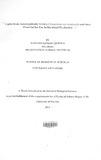| dc.description.abstract | The ever rising prices of oil in the world markets has led to the need to develop cheap, clean and locally available sources of energy such as the bio-fuels, wind and geothermal energy. Bio-diesel from oil crops may offer a solution to this problem; however, oil crops cannot realistically satisfy the demand for transport fuels, since they compete with food crops compromising food security. Under optimum growth conditions microalgae can yield sufficient amounts of oils to meet the demand for bio-diesel. This study therefore sought to determine the optimum growth conditions for biomass and lipid production for Chlamydomonas reinhardtii grown in varying environmental conditions of light intensity, photoperiod, carbon dioxide, urea and nitrogen. Screening and isolation of the alga was carried out from samples collected from Nairobi Dam and grown in Modified Bold Basal Media.
Harvesting and subsequent extraction of lipids was done after twenty days of growth. The extracted lipids were then converted to bio-diesel through transesterification process by reacting the lipids with absolute methanol and KOH catalyst. The results indicated an optimum growth at light intensity of 240 umol m-2 S-1 in an 18-hour photoperiod. The yield data on biomass of C. reinhardtii grown at this photoperiod had a mean dry weight of 53.5±1.29g after a 3 week growth period while a 6-hour photoperiod recorded 25±1.09g translating to daily increase of ~.5g/day and 1.2g/day respectively. Chlamydomonas reinhardtii showed a tolerance response of 15% CO2 concentration and a robust growth in urea of 2.4g/1, giving lipid yield of 4.9ml/g of the dry weight. Growth in 1.2g/1 of urea also gave a yield of 5ml/g of dry weight.
The yield of lipids in algae grown in 100gms of nitrogen was 0.592g in contrast to 0.102g for those grown in 250gms. Under all these optimum growth conditions it produced 98±1.79g on harvest, which on extraction gave lipid yield of22 ml. Upon transesterification it gave bio-diesel yield of 14 ml with a density of 0.89 g/ml and a soap content of 78ppm. These results implied that by optimizing these growth conditions, higher biomass density can be obtained from this species, thereby giving high lipid yield. The results from
transesterification gave evidence for using this species as a potential source for high quality bio- diesel.
Keywords: Chlamydomonas reinhardtii, Bio-diesel, microalgae, transesterification, autotrophic growth. | en_US |

